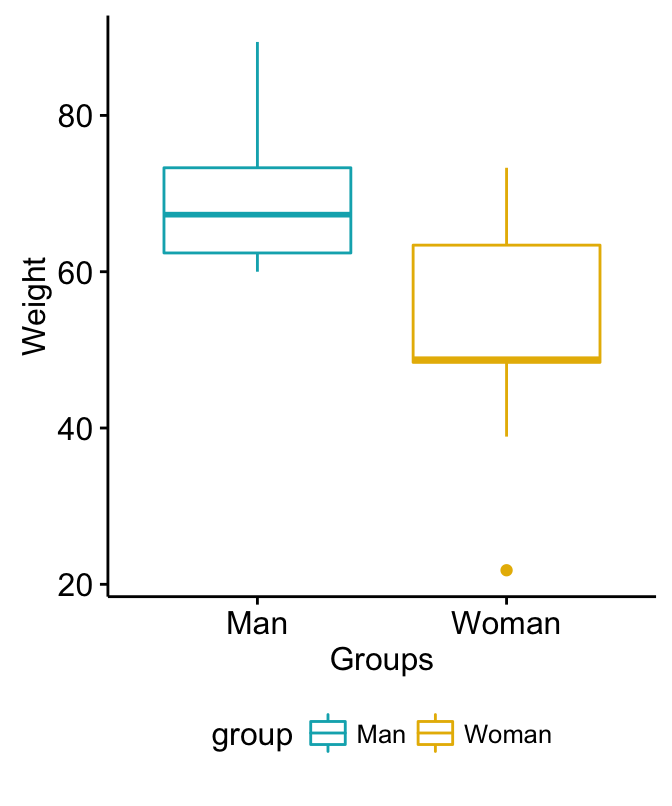拓端数据tecdat|r语言代写如何进行两组独立样本秩和检验3
原文链接:http://tecdat.cn/?p=2723
所述配对双样品的Wilcoxon检验一种的非参数检验,其可以被用于比较样品的两个独立数据。
本文介绍如何在ř中计算两个样本的秩检验。
可视化数据并在ř中计算的Wilcoxon测试
ř函数用于计算的秩检验
为了执行两个样本的Wilcoxon检验,比较两个独立样本(x&y)的均值,R函数wilcox.test()可以如下使用:
wilcox.test(x, y, alternative = "two.sided")
- x,y:数字向量
- 替代方案:替代假设允许值是“two.sided”(默认值),“更大”或“更少”之一。
将数据导入R.
-
准备数据
-
将数据保存在外部的.TXT选项卡或的的.csv文件中
-
将您的数据导入ř如下:
-
# If .txt tab file, use this
-
my_data <- read.delim(file.choose())
-
# Or, if .csv file, use this
-
my_data <- read.csv(file.choose())
在这里,我们将使用一个示例数据集,其中包含18个人(9名女性和9名男性)的权重:
-
# Data in two numeric vectors
-
women_weight <- c(38.9, 61.2, 73.3, 21.8, 63.4, 64.6, 48.4, 48.8, 48.5)
-
men_weight <- c(67.8, 60, 63.4, 76, 89.4, 73.3, 67.3, 61.3, 62.4)
-
# Create a data frame
-
my_data <- data.frame(
-
group = rep(c("Woman", "Man"), each = 9),
-
weight = c(women_weight, men_weight)
-
)
我们想知道,如果女性体重的中位数与男性体重的中位数不同?
检查数据
print(my_data)-
group weight
-
1 Woman 38.9
-
2 Woman 61.2
-
3 Woman 73.3
-
4 Woman 21.8
-
5 Woman 63.4
-
6 Woman 64.6
-
7 Woman 48.4
-
8 Woman 48.8
-
9 Woman 48.5
-
10 Man 67.8
-
11 Man 60.0
-
12 Man 63.4
-
13 Man 76.0
-
14 Man 89.4
-
15 Man 73.3
-
16 Man 67.3
-
17 Man 61.3
-
18 Man 62.4
可以按组计算汇总统计数据(中位数和四分位数间距(IQR))。可以使用dplyr包。
- 要安装dplyr软件包,请键入以下内容:
install.packages("dplyr")- 按组计算摘要统计信息:
-
library(dplyr)
-
group_by(my_data, group) %>%
-
summarise(
-
count = n(),
-
median = median(weight, na.rm = TRUE),
-
IQR = IQR(weight, na.rm = TRUE)
-
)
-
Source: local data frame [2 x 4]
-
group count median IQR
-
(fctr) (int) (dbl) (dbl)
-
1 Man 9 67.3 10.9
-
2 Woman 9 48.8 15.0
使用箱形图可视化数据
您可以按照此链接中的描述绘制R基本图:R基本图。在这里,我们将使用ggpubr R包进行基于ggplot2的简单数据可视化
- 从GitHub上的安装最新版本的ggpubr如下(推荐):
-
# Install
-
if(!require(devtools)) install.packages("devtools")
-
devtools::install_github("kassambara/ggpubr")
- 或者,从CRAN安装如下:
install.packages("ggpubr")- 可视化您的数据:
-
# Plot weight by group and color by group
-
library("ggpubr")
-
ggboxplot(my_data, x = "group", y = "weight",
-
color = "group", palette = c("#00AFBB", "#E7B800"),
-
ylab = "Weight", xlab = "Groups")

计算不成对的双样本秩检验
问题:女性和男性体重有显着差异吗?
1)计算双样本Wilcoxon检验 - 方法1:数据保存在两个不同的数值向量中。
res <- wilcox.test(women_weight, men_weight)
res-
-
Wilcoxon rank sum test with continuity correction
-
data: women_weight and men_weight
-
W = 15, p-value = 0.02712
-
alternative hypothesis: true location shift is not equal to 0
它将发出一条警告信息,称为“无法用平局计算精确的p值”。它可以通过添加另一个参数exact = FALSE来抑制此消息,但结果将是相同的。
2)计算双样本Wilcoxon检验 - 方法2:将数据保存在数据框中。
res <- wilcox.test(weight ~ group, data = my_data,
exact = FALSE)
res-
-
Wilcoxon rank sum test with continuity correction
-
data: weight by group
-
W = 66, p-value = 0.02712
-
alternative hypothesis: true location shift is not equal to 0
# Print the p-value only
res$p.value[1] 0.02711657如您所见,这两种方法给出了相同的结果。
测试的p值为 0.02712,小于显着性水平α= 0.05。我们可以得出结论,男性的中位数体重与女性的中位数体重显着不同,p值 = 0.02712。
注意:
- 如果你想测试男性体重的中位数是否小于女性体重的中位数,请输入:
wilcox.test(weight ~ group, data = my_data,
exact = FALSE, alternative = "less")- 或者,如果您想测试男性体重的中位数是否大于女性体重的中位数,请输入此值
wilcox.test(weight ~ group, data = my_data,
exact = FALSE, alternative = "greater")
如果您有任何疑问,请在下面发表评论。
▍关注我们
【大数据部落】第三方数据服务提供商,提供全面的统计分析与数据挖掘咨询服务,为客户定制个性化的数据解决方案与行业报告等。
▍咨询链接:http://y0.cn/teradat
▍联系邮箱:3025393450@qq.com



